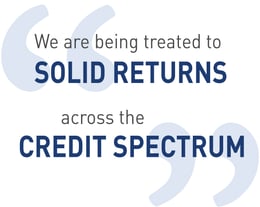
This is a “risk on” environment that has supported fixed income credit sectors - but it probably has an expiration date looming. With the US in late cycle, a multi-year spread tightening phase is unlikely. For this year however, we are being treated to solid returns across the credit spectrum. We would expect 3% to 4% returns for US Treasurys, 5% to 7% returns for investment grade credit and 8% to 10% for high yield credit in 2016.
Investment Grade
Spreads widened in 2015, particularly industrials, but when spreads gapped out earlier this year, bank and finance led the way. The levels suggested the market’s worst recession fears might become a reality and downgrades might unfold. Those fears eased quickly in mid-February when commodities rebounded and spreads tightened.
Spreads can stabilize or even narrow further as fundamentals are broadly supportive (outside of energy, metals and mining). Leverage, however, is nudging higher, and many industries are in the late cycle phase of the credit cycle.
Mergers-and-acquisitions (M&A) activity has picked up as companies try to offset stalling top-line growth and declining profitability. The focus is on appeasing shareholders, not bond holders, by prioritizing cash flow toward dividends and share repurchases. The M&A activity is adding to an already record level of new supply, but demand remains strong as both domestic and foreign buyers seek higher yields.
High Yield
Defaults rose in 2015, and I expect the default rate to move up again in 2016. However, judging by the spike in spreads earlier this year, the market feared something much worse as spreads are rarely that wide outside of recession. Like investment grade, spreads rebounded from the wides of mid-February, but only partially, so valuations remain interesting. I expect spreads can narrow further this year, enough to generate a return in the mid-single digits or perhaps better.
The fundamental trends are the same as I’ve outlined above in investment grade—decent outside of the commodity sectors, though late in the cycle. Within high yield, a significant portion of the market is priced at distressed levels. While I am cautious, given where the US is in the credit cycle, I believe there are some good values in the lower-quality buckets for investors who can carefully sift through and do their homework.

MALR015183





